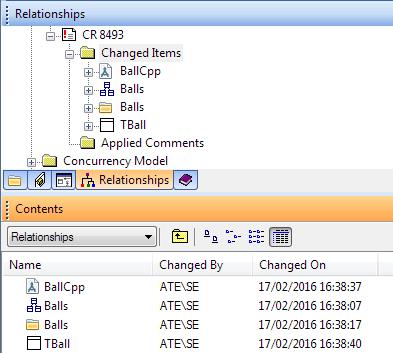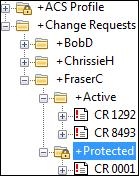Change Tracking in a Multi-User Model
In most projects, especially safety-critical projects where collection of evidence in support of certification is necessary, a transition point is reached where the introduction of a change review board may become desirable or mandated within a Quality Assurance (QA) process.
Very often this relates to a major delivery milestone after which a project requires a more formal change control process to ensure integrity of previously reviewed artifacts is protected. At this stage, it is still important that the model can be shared between collaborating users, however it needs to be changed in a controlled manner and in conformance with a formal change process. The change tracking feature of Modeler supports this need. The Change Tracking feature requires a Change Tracking license.
Change tracking can be enabled model wide by a model owner. After being enabled, this enforces that all users must select and make a Change Note active when making edits to the model. All edits to the model are then tracked against the Change Note set active. Different users can select different Change Notes and therefore using this mechanism it is possible to track the work performed on individual change requests and use the automatically collected change information in support of review and audit processes.
When complete, a Change Note can be marked as Closed to prevent further use. This renders them unavailable for tracking further changes. When necessary, a user with Model Owner privileges can reopen a closed Change Note.
Usage
From Modeler, On the Property Pages for the Model, select the Enable Change Tracking check box. This enables the Change Tracking feature model wide.

The list of items associated with a particular Change Note can be browsed in the Relationships pane.

Change Notes are model items and hence are visible in the model. On the Property Pages of a Change Note you can use the View Change Summary button to switch between a view of the changes and a list of items affected by those changes.

Benefits
Communication of change: After being enabled, change tracking ensures that an audit trail is maintained against all model items. This is useful for enhancing the communication of change between collaborating users.
Detailed changes: The detailed changes information includes a full audit trail of all the changes made. This information is accessible through the automation interface and hence can be used for custom reports, change metrics or audit purposes.
Changed items synopsis: A synopsis of what items were touched in the process of completing a change is also available. In the Relationships pane, you can see which items have been affected by a Change Note. You can quickly find a Change Note in the Relationships pane by right-clicking the Change Note, pointing to Find, and then clicking In Relationships Browser. This list of items can be used as a check-list for the review cycle.
Recommendations
Modeler CM’s features empower you to choose the level of tracking and control you deem appropriate for your project in its particular stages of development. However, this does come at the cost of adding information to the model and requiring additional processes to support Change Notes. At certain project stages, a barrier preventing changes is needed. For example: after delivery. At other project stages, such a barrier is not useful. For example: early in the project lifecycle when the aim is to use the model to improve communication of ideas between people.
Each Change Note should cover a single set of dependent changes by one user, analogous to the task-specific, user-specific, Change Requests utilized in most CM systems, rather than multiple changes by multiple developers. Since Change Notes take their access permissions from the owning Package, we recommend that you have a separate Package hierarchy in the model that allows a model owner to control access to Change Notes, for example:

Using temporary Change Notes: Change tracking requires that all users of the model have an active change node when making edits and a Change Note monitors all modifications made by the user in their session throughout the Model. If parts of the model are not under formal change control, then it may be necessary to create dummy Change Notes for users who are changing these. If many people are using the same temporary Change Notes then the number of links can become large. When using this technique therefore, housekeeping is recommended to regularly delete temporary Change Notes from the model.
Housekeeping: Change tracking will increase the storage space required for a model and increase the time taken to perform model-level operations, such as, versioning and model imports and exports. If the number of changes is great, then you may elect to periodically delete Change Notes from the model. One option is to version the model when a particular milestone is complete, delete all the closed Change Notes, and then start again. An alternative is to version the model after the completion of a particular change and then delete the Change Note. The Change Notes will be stored in the versioned model and hence are not lost. An external cross reference of Change Notes to Model Versions could be maintained in, for example, an external CM tool or external database. If the model has been versioned then it can be opened for downstream audit to recover the complete details of changes associated with a Change Note.
Deleting Change Notes: When deleting a Change Note a different Change Note must be set to active, so that a record of the deletion is tracked. One suggestion is to have a Change Note in the model for use by a model administrator for deleting Change Notes.
Change Notes can also be stereotyped to record information relating to your process, for example, adding a tag definition that records a particular review status, such as In Progress, Reviewed and Completed. A description can also be added to the Change Note to summarize the overall change.